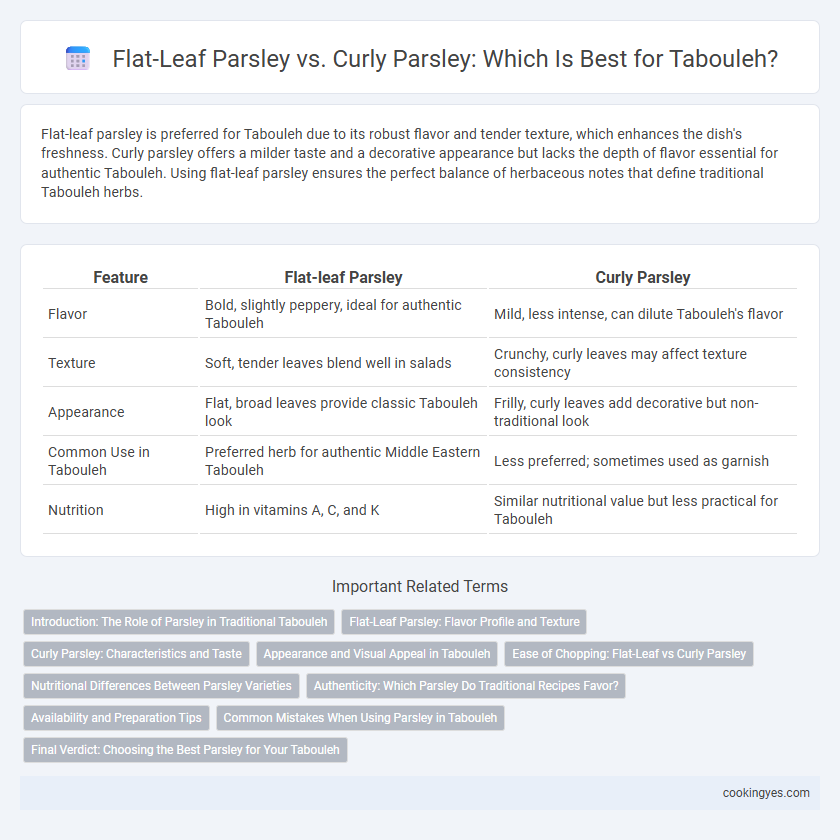Flat-leaf parsley is preferred for Tabouleh due to its robust flavor and tender texture, which enhances the dish's freshness. Curly parsley offers a milder taste and a decorative appearance but lacks the depth of flavor essential for authentic Tabouleh. Using flat-leaf parsley ensures the perfect balance of herbaceous notes that define traditional Tabouleh herbs.
Table of Comparison
| Feature | Flat-leaf Parsley | Curly Parsley |
|---|---|---|
| Flavor | Bold, slightly peppery, ideal for authentic Tabouleh | Mild, less intense, can dilute Tabouleh's flavor |
| Texture | Soft, tender leaves blend well in salads | Crunchy, curly leaves may affect texture consistency |
| Appearance | Flat, broad leaves provide classic Tabouleh look | Frilly, curly leaves add decorative but non-traditional look |
| Common Use in Tabouleh | Preferred herb for authentic Middle Eastern Tabouleh | Less preferred; sometimes used as garnish |
| Nutrition | High in vitamins A, C, and K | Similar nutritional value but less practical for Tabouleh |
Introduction: The Role of Parsley in Traditional Tabouleh
Flat-leaf parsley is the preferred herb in traditional Tabouleh due to its bright, earthy flavor and tender texture, which enhances the freshness of the salad. Its vibrant green leaves provide a more robust taste compared to curly parsley, making it essential for achieving the authentic tabouleh flavor profile. Curly parsley, while visually decorative, offers a milder flavor and tougher texture, making it less suitable for this classic Middle Eastern dish.
Flat-Leaf Parsley: Flavor Profile and Texture
Flat-leaf parsley offers a robust, slightly peppery flavor that enhances the traditional freshness of Tabouleh, providing a more pronounced herbal note compared to curly parsley. Its tender, broad leaves have a smoother texture, blending seamlessly with the bulgur and tomatoes without overpowering the dish. This variety maintains its vibrant green color and softness after chopping, making it the preferred choice for authentic Tabouleh recipes.
Curly Parsley: Characteristics and Taste
Curly parsley features tightly ruffled leaves with a vibrant green color, offering a milder, slightly peppery flavor compared to flat-leaf parsley. Its decorative appearance makes it visually appealing for tabouleh, while its subtle taste complements the fresh lemon and tomato elements without overpowering them. The texture of curly parsley adds a pleasant crunch, enhancing the overall mouthfeel of this traditional Levantine salad.
Appearance and Visual Appeal in Tabouleh
Flat-leaf parsley features broader, smoother leaves that provide a vibrant green color and clean texture, enhancing the fresh and crisp appearance of Tabouleh. Curly parsley, with its tightly ruffled and bushy leaves, adds a decorative, lush look but can overwhelm the dish's delicate visual balance. Choosing flat-leaf parsley highlights the traditional, refined aesthetic of Tabouleh, making the herb integration appear more seamless and appetizing.
Ease of Chopping: Flat-Leaf vs Curly Parsley
Flat-leaf parsley is preferred for Tabouleh due to its ease of chopping, as its broad, smooth leaves cut more evenly and quickly compared to curly parsley. Curly parsley's ruffled texture can be more challenging to finely chop, often resulting in uneven pieces that affect the salad's texture. Using flat-leaf parsley ensures a consistent, delicate herb distribution in traditional Tabouleh recipes.
Nutritional Differences Between Parsley Varieties
Flat-leaf parsley contains higher levels of vitamins A and C, as well as antioxidants, compared to curly parsley, making it a more nutrient-dense choice for tabouleh. Curly parsley provides a slightly higher amount of dietary fiber and chlorophyll, which contributes to its vibrant color and digestive benefits. Both varieties offer essential minerals like iron and potassium, but flat-leaf parsley's richer nutrient profile often enhances the health benefits of traditional tabouleh dishes.
Authenticity: Which Parsley Do Traditional Recipes Favor?
Traditional Tabouleh recipes predominantly favor flat-leaf parsley for its robust flavor and tender texture, which blend seamlessly with bulgur, tomatoes, and mint. Curly parsley, while visually appealing, tends to have a milder taste and tougher leaves that can alter the authentic balance of this Levantine salad. Flat-leaf parsley's earthy aromatic profile is considered essential for maintaining the dish's genuine freshness and vibrancy.
Availability and Preparation Tips
Flat-leaf parsley is preferred for tabouleh due to its robust flavor and easy availability in most supermarkets, whereas curly parsley is often used more for garnish and is less commonly found fresh. When preparing flat-leaf parsley for tabouleh, finely chop to release its vibrant aroma and crisp texture, ensuring it blends well with bulgur and tomatoes. Washing parsley thoroughly and drying it before chopping prevents excess moisture from diluting the dish's fresh, herbaceous taste.
Common Mistakes When Using Parsley in Tabouleh
A common mistake in Tabouleh preparation is using curly parsley instead of flat-leaf parsley, which impacts the dish's authentic flavor and texture. Flat-leaf parsley provides a brighter, more robust taste and a finer, more tender texture essential for traditional Tabouleh. Choosing the wrong parsley variety can result in a less aromatic and visually unappealing salad.
Final Verdict: Choosing the Best Parsley for Your Tabouleh
Flat-leaf parsley is preferred in traditional tabouleh for its robust flavor and tender texture, enhancing the salad's fresh and vibrant profile. Curly parsley, while visually appealing, carries a milder taste and tougher leaves that may dilute the dish's authenticity. Choosing flat-leaf parsley ensures a balanced and flavorful tabouleh that honors its Mediterranean origins.
Flat-leaf parsley vs Curly parsley for Tabouleh herbs Infographic

 cookingyes.com
cookingyes.com